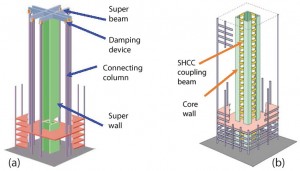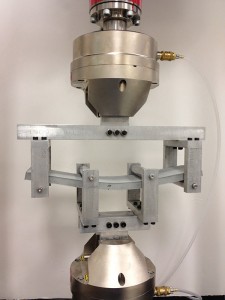The most important concrete property in the ACI 318 Building Code is compressive strength. This reflects the notion of using concrete as a strong material against compressive stress in structural members. Tensile forces are expected to be carried by prestressing or reinforcing steel. These fundamental structural design concepts of putting concrete in compression and steel in tension have largely worked very well.
In recent years, the increasing attention to the need for structural resiliency and environmental sustainability has shed new light on the limitations of concrete material. There are plenty of visual examples of fracture failure of reinforced concrete members during major earthquakes, for example. It is also known that the durability of concrete structures is often compromised by the presence of cracks while exposed to an aggressive environment. The high carbon and energy footprints of civil infrastructure are closely linked to the need for repeated repairs during its service life.
What if concrete can be made ductile?
A ductile concrete can result in high structural load capacity, even though high structural strength is more commonly associated with high material strength. For structural members whose capacity is limited by brittle fracture failure of concrete, the governing parameter is tensile ductility, not the compressive strength. As an example, S. Billington at Stanford University conducted a comparative test of a shear panel using a normal concrete of 7,250 psi compressive strength and a ductile concrete of 5,950 psi compressive strength. The ductile concrete panel yielded a higher structural shear capacity of 12,590 lbf compared to 8,540 lbf for the normal concrete panel. This illustrates that structural capacity does not always correlate with material compressive strength. Apart from enhancing load capacity, ductility of concrete also embeds damage tolerance, and therefore resiliency, into structures.
While concrete structural durability is often associated with concrete impermeability, there is evidence that a densely packed concrete does not always translate into structural durability. As example, P.K. Mehta of UC Berkeley examined the durability of concrete bridge decks and concluded that those built with high strength, densely packed concrete have, in recent years, demonstrated a lower service life than their predecessors using lower strength concrete. The underlying cause of the discrepancy in durability expectations is that the lower permeability concrete is measured in the laboratory without load application, whereas the field permeability of concrete structures under load is dominated by the presence of cracks. Hence, material durability (impermeability) does not always translate into structural durability. Instead, a ductile concrete can suppress cracking with wide crack width and lend itself to supporting structural durability.
A ductile concrete, with substantially higher tensile ductility compared to normal concrete, can contribute to higher structural resiliency and environmental sustainability, the latter by virtue of the need for less frequent repairs.
The technology to making concrete ductile, with tensile strain capacity several orders of magnitude higher than normal concrete, has been realized in recent years. This class of concrete, often known as strain-hardening cementitious composites (SHCC), exhibits a tensile stress-strain curve with a shape that resembles that of a ductile metal, while maintaining a compressive strength of that of a normal to high strength concrete. While still expensive, the material has found its way into full-scale structural applications in several countries and especially in Japan. The Japan Society of Civil Engineers has published a design recommendation on SHCC to fill the gap left by standard concrete structural design codes that emphasize mainly the compressive strength of concrete. In the popular press, SHCC has often been called “Bendable Concrete” due to its ability to undergo large flexural deformation even without steel reinforcement (Figure 1).
Figure 2 illustrates the change in building design with the introduction of this new SHCC technology, utilized in high-rise construction project in Japan. In the design without SHCC (Figure 2a), the building self-centers under seismic loading by means of two pairs of super-frames that bracket the whole building in two perpendicular directions. Each super-frame is constructed of two huge columns that rise from the building foundation to the top of the building, and connected through dampers at the ends of an enormous sky beam. The 9-foot- deep beam is difficult to hoist to the top of the building, requiring fabrication at the building top. In the SHCC design (Figure 2b), the super-frames were eliminated and replaced with four SHCC precast coupling beams to connect the core walls on each floor. The damage tolerant SHCC coupling beams are expected to undergo large shear deformation in a ductile mode with high energy-absorption capability.

Figure 2: (a) Previous design with super-frame; (b) New design with SHCC coupling beams. Courtesy of T. Kanda, Kajima Corporation, Japan.
In 2005, the Michigan Department of Transportation conducted a demonstration project on a new type of jointless bridge deck. The conventional expansion joint was replaced by a 9 inch thick SHCC link-slab, measuring 16.5 feet x 60.75 feet. The link-slab connects the adjacent normal concrete bridge deck and accommodates temperature-induced expansion and contraction of the underlying steel girders, acting as an invisible joint. The design requirements called for a tensile strain capacity of 2% in the link-slab material, a value not achievable with standard concrete of any compressive strength.
Other recent use of SHCC includes repair applications, such as the rehabilitation of the Mitaka Dam and the repair of the Hida tunnel lining in Japan.
While the applications in transportation, building, water and energy infrastructures appear widely different, the primary feature of SHCC is its ability to meet tensile deformation and durability demands. Ductile concrete can serve as a new material technology that contributes to enhancing civil infrastructure resiliency and sustainability. Although current application of the material remains limited, the advantages of ductile concrete will likely broaden its adoption in coming years when a supply chain of this new class of concrete is established globally.▪

